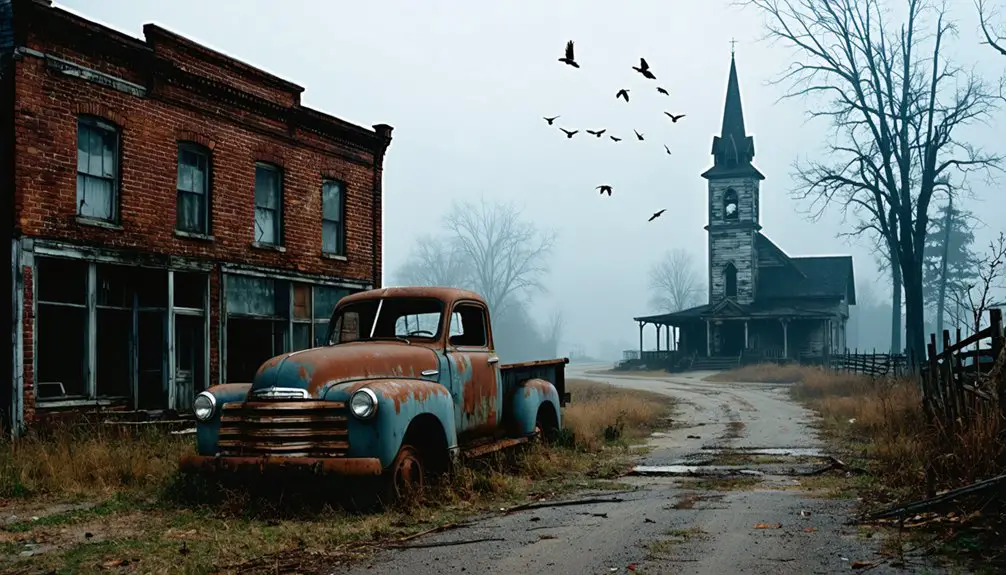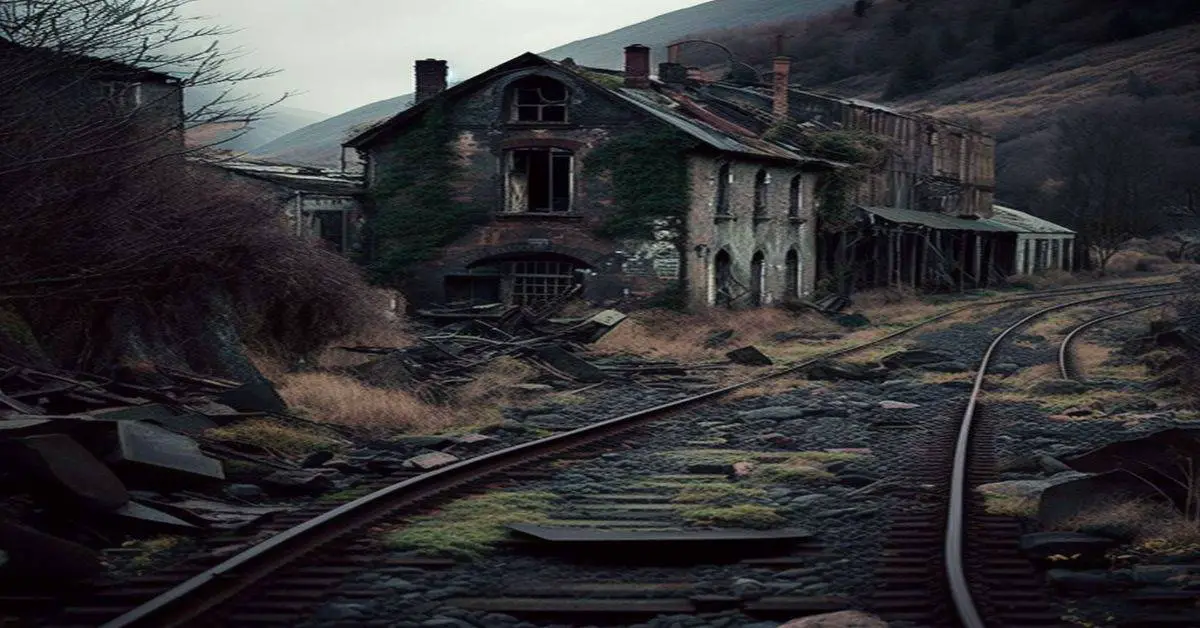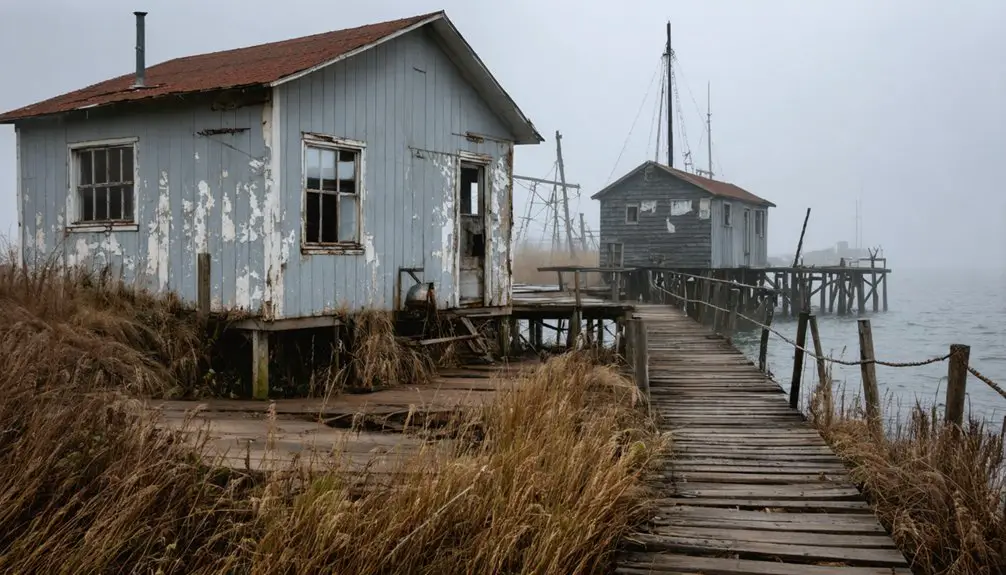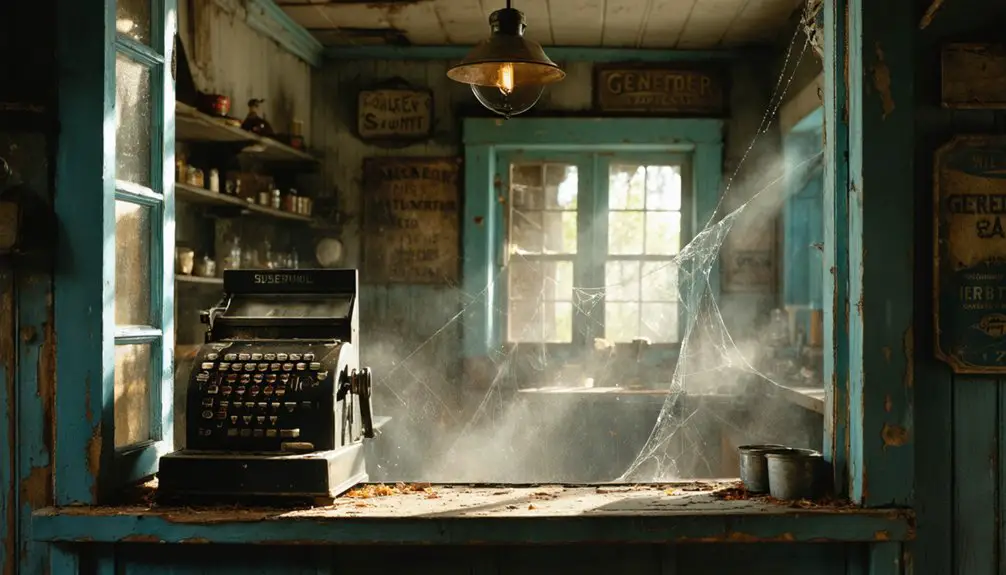You’ll find Lawesburg’s traces beneath modern-day Appleton, Wisconsin at 44°15′31″N and 88°23′00″W. This mid-19th century settlement merged with Appleton and Grand Chute in 1853 to form the incorporated Village of Appleton. German and northern European pioneers originally built wooden homes along the Fox River, establishing a self-sufficient community. While no distinctive markers remain, the settlement’s influence on Appleton’s development holds fascinating historical significance.
Key Takeaways
- Lawesburg was a 19th-century village near Appleton, Wisconsin that merged into the incorporated Village of Appleton in 1853.
- The ghost town’s former location is at coordinates 44°15′31″N and 88°23′00″W within modern-day Appleton.
- No distinctive markers remain to identify Lawesburg’s original boundaries, as urban development has completely absorbed the area.
- The settlement was strategically positioned along the Fox River, supporting trade between the Great Lakes and Mississippi River.
- German and Northern European settlers established Lawesburg as a self-sufficient community with wooden homes and workshops.
Origins and Early Settlement
While many Wisconsin settlements emerged during the mid-19th century territorial expansion, Lawesburg established itself as a distinct village near present-day Appleton in Outagamie County.
Lawesburg carved out its own identity as a Fox River settlement near Appleton during Wisconsin’s territorial growth in the 1800s.
You’ll find that influential settlers like Morgan L. Martin, Theodore Conkey, and Abram B. Bowen helped shape early community dynamics alongside the newly established Lawrence Institute.
The settler experiences in Lawesburg reflected the broader regional patterns of European immigration.
You’d have encountered mainly German and northern European families drawn by the promise of land and opportunity in the Wisconsin Territory after 1836.
These pioneers built wooden homes and workshops, creating a self-sufficient community that capitalized on the Fox River’s resources. Local residents often shared tales of the area being cursed by tribes who previously inhabited the region.
The village’s strategic location supported river-based trade before railroads revolutionized transportation in the area, similar to how the railroad bypassing of other Wisconsin towns like Imalone led to their eventual abandonment.
Life Along the Fox River
The Fox River shaped life profoundly for both Native Americans and European settlers in the Lawesburg area. The waterway’s abundant resources supported Native American traditions for generations before French fur trade activities began in the 1600s. Relations between settlers and natives were relatively peaceful until tensions escalated during the Black Hawk War of 1832.
You’ll find evidence of this rich history in the seasonal villages that once dotted the riverbanks. By 1834, early Norwegian settlers began establishing communities along the river’s fertile shores.
- Winnebago and Menominee tribes established settlements to harvest fish and game
- French traders collaborated with natives to collect valuable beaver pelts
- Rapids and high bluffs influenced where people could settle and travel
- The river connected the Great Lakes to the Mississippi River system
- Local groups like the Three Fires Confederacy maintained villages until forced removal in 1835
This essential waterway continued serving as a lifeline for transportation, trade, and sustenance until advancing settlement permanently altered the region’s character.
Merging With Appleton
In 1853, Lawesburg joined with neighboring villages Grand Chute and Appleton to form the incorporated Village of Appleton, marking a pivotal shift in the region’s development. The merger motivations centered on creating a stronger administrative presence along the Fox River while streamlining governance efficiency for the growing settlements.
Under the leadership of John F. Johnston, the first village president, you’d have witnessed the emergence of a unified community poised for industrial growth. The consolidation proved timely, as the paper industry began flourishing that same year. A comprehensive disambiguation page would later help researchers distinguish this historic merger from other places named Appleton.
You’ll find that this strategic merger enabled better coordination of resources, improved public services, and laid the groundwork for significant developments like the Vulcan Street Plant in 1882. Though Lawesburg lost its independent status, it became an integral part of Appleton’s expanding urban landscape.
Historical Legacy and Impact
Today, remnants of Lawesburg’s pioneer heritage endure through the cultural fabric of modern Appleton.
You’ll find the village’s economic significance reflected in the development patterns along the Fox River, where early trade routes shaped the region’s growth. The settlement’s cultural identity lives on through family histories and community traditions that have been woven into Appleton’s character. Similar to the mysterious town of Doveland, Wisconsin, no official maps or records confirm its location or existence. Like Bodie’s transformation from a mining camp settlement, the area experienced significant changes as industry evolved.
- Original settler family lines continue to influence local governance and business
- River-based trading legacy shaped modern transportation corridors
- Pioneer-era buildings, though mostly gone, influenced local architectural styles
- Agricultural heritage remains visible in surrounding farmland patterns
- Community traditions from Lawesburg persist in modern Appleton festivals
The village’s transformation from independent settlement to part of Appleton exemplifies the dynamic nature of Wisconsin’s 19th-century urbanization, marking a vital chapter in the region’s development.
Remnants and Modern-Day Location
Nestled within modern-day Appleton’s city limits, Lawesburg’s physical traces have largely vanished beneath urban development.
You’ll find this historic ghost town at coordinates 44°15′31″N and 88°23′00″W, positioned near the Fox River at an elevation of 791 feet above sea level.
While you can freely access the area as part of Appleton’s metropolitan landscape, don’t expect to find many remnant structures from the original village.
The site’s been completely absorbed into the modern city, with new infrastructure and buildings replacing the old settlement.
Like many ghost towns in America, Lawesburg fell victim to economic decline and shifting populations.
Today, the area is a short distance from the Appleton Transit Center where buses now traverse the former town’s footprint.
You won’t see any distinctive markers or signs identifying Lawesburg’s former boundaries.
If you’re determined to explore this piece of Wisconsin history, you’ll need to rely on historical research to pinpoint where specific village components once stood.
Frequently Asked Questions
What Kinds of Businesses and Industries Operated in Lawesburg Before Its Decline?
You’d think it was just trees, but Lawesburg’s local economy buzzed with sawmills, grocery stores, hotels, blacksmith shops, and meat markets, while railroad influence shaped where businesses thrived or died.
How Many People Lived in Lawesburg at Its Peak Population?
You’ll find precise peak demographics are unrecorded, but given typical Wisconsin village patterns and population decline trends of the era, it’s estimated several hundred people lived there during its height.
Were There Any Notable Crimes or Scandals in Lawesburg’s History?
Like a page torn from history, you won’t find any documented crime history or scandal events recorded. The tiny village’s early absorption into Appleton left little trace of such occurrences.
What Happened to the Original Buildings When Lawesburg Was Incorporated?
You’ll find that original buildings weren’t demolished during incorporation but gradually declined over time. Some structures earned historical significance status, while others faced neglect despite early preservation efforts.
Did Any Famous Historical Figures Ever Visit or Stay in Lawesburg?
Picture quiet streets where history’s whispers fade – you won’t find records of any famous visitors to this spot, though regional figures like George W. Lawe and Morgan L. Martin likely passed through.
References
- https://usghostadventures.com/haunted-stories/the-legend-of-doveland-wisconsin-the-vanishing-town/
- http://shunpikingtoheaven.blogspot.com/2016/05/a-wisconsin-ghost-town.html
- https://en.wikipedia.org/wiki/Grand_Chute_(ghost_town)
- https://kids.kiddle.co/List_of_ghost_towns_in_Wisconsin
- https://en.wikipedia.org/wiki/List_of_ghost_towns_in_Wisconsin
- https://usghostadventures.com/haunted-stories/haunting-stories-of-sleepy-hollow-road/
- https://pbswisconsin.org/news-item/southern-wisconsins-ghost-towns-leave-behind-vital-stories/
- https://www.littlechutewi.org/DocumentView.asp?DID=200
- https://en.wikipedia.org/wiki/Fox_River_Settlement
- https://historyonthefox.wordpress.com/2022/11/01/the-era-when-the-fox-river-valleys-indians-and-settlers-lived-along-side-each-other/



